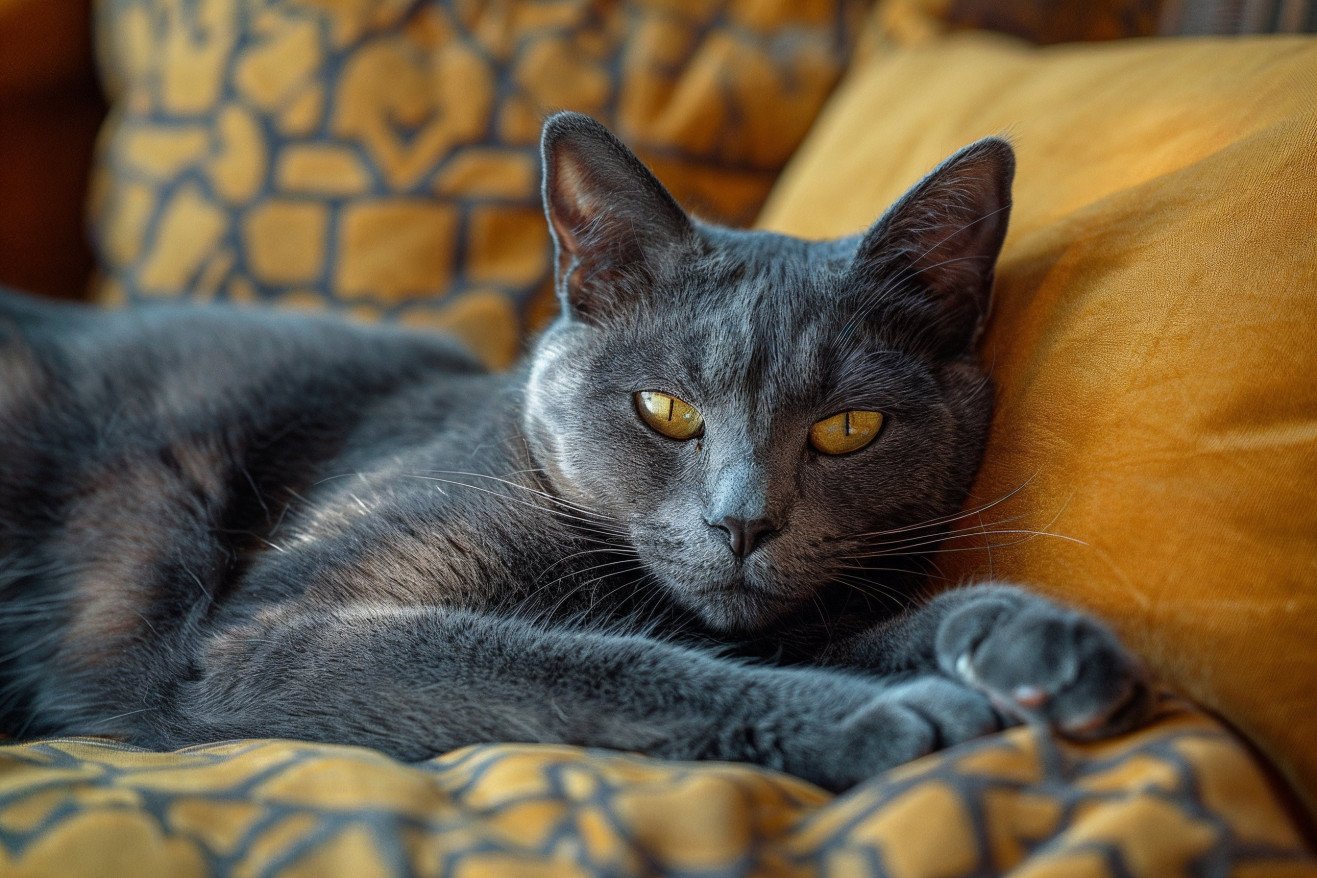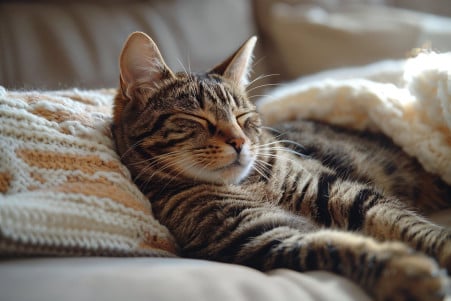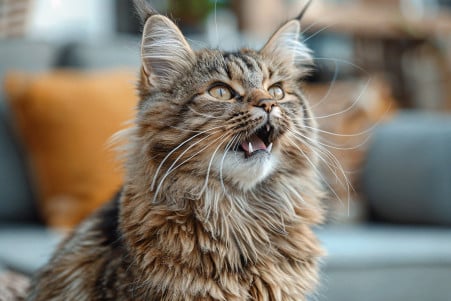Why Doesn’t My Cat Purr? Decoding Feline Silence
24 February 2024 • Updated 22 February 2024

Purring is often thought of as a sign of a happy cat, but some cats never seem to do it. There are a few reasons why your cat may not purr as much, including individual personality differences and breed-specific traits.
That said, if your cat isn’t purring, it’s not necessarily a cause for concern, although a sudden change in purring behavior may indicate stress or a health problem. Your cat’s age may also play a role in how much it purrs.
We’ll cover a number of reasons, including insights from veterinarians, physiological and psychological research, and breed-specific factors, to help explain why some cats don’t purr. By looking at these different angles, we hope to give you a comprehensive understanding of what’s normal and abnormal when it comes to purring in cats, so you can figure out whether your cat’s lack of purring is just a personality quirk or something you should be worried about.
Why doesn't my cat purr?
The Science of the Purr
The purr is a unique and comforting sound that is the result of a complex physiological process. A study in Current Biology found that purring is more than just the result of the laryngeal muscles that were previously believed to be responsible for the sound.
According to voice scientist Christian Herbst, who co-authored the study, it is the presence of a pad in the cat’s vocal cords that is the most important factor in the production of the low-frequency sounds that make up the purr. The pad makes the vocal cords thicker, which allows them to vibrate at lower frequencies, a process similar to the ‘vocal fry’ in humans.
This vibration, which is part of a process called flow-induced self-sustained oscillation, doesn’t require any active muscle contraction on the part of the cat.
The use of excised larynges in the study by the researchers has led to some important questions about the limitations of this kind of research.
This has led to the question of whether or not the essence of a live cat’s purr can be captured in this kind of research.
The ongoing debate about the exact process of purring is evidence of the complexity of feline communication, and it demonstrates why some cats may be natural purrers while others may purr less or not at all.
The Socialization Orchestra: How a Cat’s Purring Reflects Its World
Socialization is one of the most important factors that determines whether or not a cat will purr. Early experiences during the sensitive period of kittenhood can set the stage for a lifetime of social behavior in cats, including trust and friendliness toward humans, which is often accompanied by more purring.
This is further explained in a study in PMC by Dennis C. Turner, which notes that frequent handling of kittens during their second to seventh weeks of life often leads to adult cats that purr more when interacting with humans.
The length of time that cats are separated from their human companions also affects their purring. A study on PubMed by Matilda Eriksson found that cats tend to show a contact-seeking rebound, including more purring, after longer separations from their owners. This suggests that cats form strong social bonds with their people, and their vocalizations reflect the strength of those bonds.
In addition, the domestication of cats and the changing relationship between cats and humans have led to purring as a form of communication. Studies have shown that cats use different vocal signals to get attention and food from humans, demonstrating that their vocalizations are closely tied to their social world.
These findings show that a cat’s environment, including the amount of human contact they receive and the quality of their social interactions, has a big impact on their use of vocalizations like purring. As we move on to look at genetic factors and breed differences, we will continue to untangle the web of influences on the mysterious phenomenon of purring in cats.
Genetics and the Genetic Mystique of Cat Purring
Genetics are a big part of what makes cats the way they are, and that includes their purring habits.
A paper published in PMC and authored by Hannes Lohi, explores the heritability of feline behavior, and it suggests that cats can inherit their purring habits just like they can inherit their fur color or the shape of their eyes.
Based on a large survey of more than 5,000 cats, the study found that feline behavior traits are moderately heritable, with heritability estimates ranging from 0.4 to 0.53, which means that almost half of the variation in certain behaviors, which could include purring, is due to genetics.
In addition, studies of specific cat breeds have shown that there are differences in behavior between breeds. For example, some breeds may be more genetically inclined to be active and outgoing while others may be more inclined to be less vocal, including purring.
In fact, Technology Networks notes that the behaviors of breeds like the Turkish Van and the Maine Coon may have been inherited from their ancestors. Since these traits are heritable, that means that a cat’s inclination to purr, or not, can be inherited.
As we think about the wide range of purring behaviors seen in different cat breeds, it’s clear that genetic influences and individual differences both play a role in determining how each cat purrs. This realization can help us better understand the complex ways that age-related changes may also impact a cat’s purring behavior.
Age-Related Changes in Purring
Cats’ vocalizations, including purring, change as they age. Young kittens use vocalizations to communicate with their mothers, and the sounds they make can indicate things like hunger and cold, which can include purring.
As cats grow older, purring continues to be a form of communication but it becomes more complex and can indicate everything from contentment to pain to fear. However, while there are changes in vocal behavior when cats are young, there are also changes in vocal behavior when cats are old.
Older cats, in particular, are known to increase their vocalizations, including changes in purring. A study in PMC by Daniëlle A. Gunn-Moore explains that cognitive dysfunction syndrome (CDS), which is similar to dementia in humans, is a common cause of increased vocalization in aging cats, and it’s often due to disorientation or attention-seeking behavior.
This shows that purring is a complex behavior that can be impacted by the cognitive changes that come with aging.
In addition, a cat’s social and environmental history also impacts its vocalizations. A study in PMC found that feral cats purr less than domestic cats, likely because they have less interaction with humans and different environmental pressures. Meanwhile, a study in Veterinary Sciences found that the prevalence of disease and behavioral changes in aging cats has a significant impact on the range and reasons for their vocalizations, including purring.
Pet parents should pay attention to these vocalizations as they can indicate underlying health issues or normal aging changes that need to be addressed. Knowing what your cat’s purring means can help ensure that your cat is as healthy and happy as possible as they move through the different stages of their lives.
Vocal Health: When Silence Speaks Volumes
While cats use a variety of vocalizations to communicate, purring is one of the most well-known. However, medical issues can change or even eliminate this unique vocalization. For example, paralysis, neoplasia, and laryngeal inflammation can all have a significant effect on a cat’s ability to purr.
According to Vet Help Direct, anatomical differences or abnormalities in the nervous system may mean that some cats can’t physically purr. Meanwhile, ResearchGate explains that laryngeal paralysis often results in changes in vocalization, including the absence of purring. In addition, neoplasia or laryngeal inflammation may block the structures needed for purring.
Veterinarians play a critical role in the diagnosis and treatment of conditions that impact a cat’s ability to purr. For example, as outlined on PubMed, medical treatment is needed to diagnose and treat obstructive inflammatory laryngeal disease, which can cause clinical signs that are similar to neoplasia.
Cat owners need to pay attention to their cats’ purring behavior, as it can be an important sign of an underlying health issue. If a cat’s purring behavior changes, cat owners should make sure to see a vet as soon as possible, as this could be an early sign of a health condition that needs to be evaluated and treated by a medical professional.
The Psychology of Purring: Stress and Trauma in Cats
While a cat’s purr, often termed a quiet orchestration, is a result of their mindset, stress and trauma can’t be seen but can certainly be detected in a cat’s purr. PetMD notes that similar to humans, cats can experience depression and anxiety following traumatic events.
This can manifest in a cat’s purring, with changes in the frequency of purring, whether an increase or decrease, indicating that the cat is in distress or discomfort.
Dealing with trauma in cats can take time and patience. A study on trauma-induced aggression in cats on Academia.edu found that changes in behavior, including purring, could be a result of stress-induced aggression. To help cats overcome this, professionals use treatment methods like desensitization and counter-conditioning, which PetMD says help cats get used to stimuli in a controlled environment and learn to associate them with positive experiences.
Of course, environmental stressors can also impact how a cat’s psychological state is expressed. Heart + Paw says that anxiety or nervousness can lead to purring that seems like a cat is happy when they’re actually asking for help or comfort. That’s why it’s important to pay attention to and understand these psychological signs as well as physical ones, so that we can create a more supportive and understanding environment for our cats.
The Sound of Silence: What It Means When a Cat Doesn’t Purr
The lack of a cat’s purr can be just as mysterious as the cat itself. A cat’s purring behavior is influenced by a number of things, from the physiological factors of a cat’s unique body to the genetic factors that determine a cat’s personality. A cat’s socialization, the environment it lives in, and the specific relationship it has with its owner can all play a role in how much a cat purrs.
It’s also important to note that not all cats will purr to show contentment, and a lack of purring doesn’t necessarily mean a cat is unhappy or unhealthy. That said, it’s important to be aware of any changes in a cat’s purring behavior, and if a cat suddenly stops purring, it’s important to have a vet check it out to make sure there are no underlying health issues.
Purring is just one part of a cat’s complex communication system. Understanding this system can help cat owners and cat lovers better understand and connect with their pets, and appreciate the rich non-verbal world that cats inhabit.


